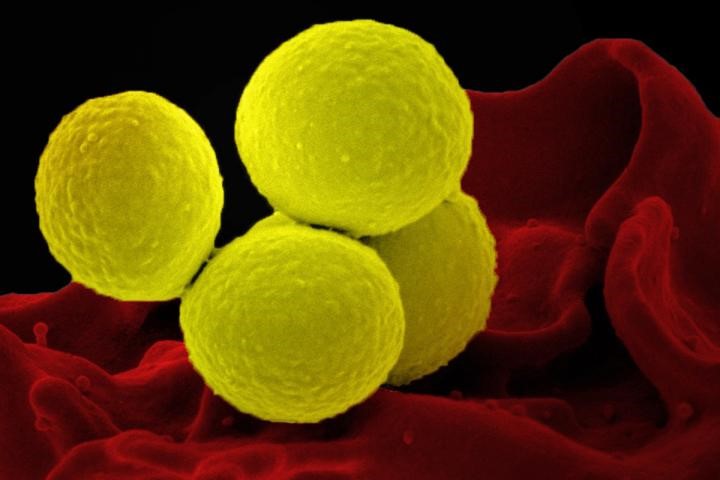![<i>Staphylococcus aureus</i> bacteria is linked to up to 50,000 deaths each year in the U.S. [NIAID]” /><br />
<span class=](https://genengnews.com/wp-content/uploads/2018/08/Jan20_2017_NIAID_StaphylococcusAureus2062013104-1.jpg) Staphylococcus aureus bacteria is linked to up to 50,000 deaths each year in the U.S. [NIAID]
Staphylococcus aureus bacteria is linked to up to 50,000 deaths each year in the U.S. [NIAID]
They have a taste for our blood, particularly the iron it contains, and they can leave us sickened, weakened, even dead. They are Staphylococcus aureus bacteria, and their depredations are linked with up to 50,000 deaths each year in the United States.
Should these microbial vampires resist antibiotics, as they often do when they manifest as hospital-acquired infections, they won’t be deterred by garlic, wolfsbane, or sacred objects. They may, however, be vulnerable to light—provided they are also exposed to an enzyme-activating small molecule.
The small molecule, called ’882 for short, has been identified as a potential S. aureus killer by scientists based at the Vanderbilt University School of Medicine. So far, these scientists, led by Eric Skaar, Ph.D., have evaluated ’882 in mouse models of skin and soft tissue infections. The results have been encouraging.
In combination with light, the small molecule can reduce bacterial burden in infected mice. It does so by activating a bacterial enzyme, which in turn induces accumulation of a photoreactive molecule. Details of the small molecule’s mechanism appeared July 24 in the Proceedings of the National Academy of Sciences, in an article entitled “Antibacterial Photosensitization through Activation of Coproporphyrinogen Oxidase.”
“We report…the identification of a small-molecule activator of coproporphyrinogen oxidase (CgoX) from Gram-positive bacteria, an enzyme essential for heme biosynthesis,” the article’s authors wrote. “Activation of CgoX induces accumulation of coproporphyrin III and leads to photosensitization of Gram-positive pathogens.”
Photodynamic therapy—light combined with a photosensitizing chemical—is used to treat certain cancers and skin conditions, including acne. But according to Dr. Skaar, it has never really taken off as a treatment for infection because you kill the human cells, too.
That may change, suggested Dr. Skaar, who said, “Now we have a molecule that only targets the bacterial enzyme in the pathway so you can selectively make bacteria photosensitive.”
The molecule, which was identified through Vanderbilt University Medical Center's high-throughput screening facility and developed in collaboration with the lab of Gary Sulikowski, Ph.D., is one of only about a dozen synthetic small molecules known to activate, rather than inhibit, an enzyme.
When the PNAS paper appeared, Dr. Skaar summarized its contents in a tweet: “If S. aureus is going to drink our blood like a vampire, let's kill it with sunlight.”
“That thing has been retweeted so many times,” said Dr. Skaar. “It's one of the most popular tweets I've ever put out about our research.”
While colorful, the tweet does get to the heart of the matter. “S. aureus breaks open the blood cells and grabs the hemoglobin and pulls the iron out,” Dr. Skaar said. Other Gram-positive pathogens probably do the same thing. “But the S. aureus systems,” Dr. Skaar noted, “are by far the most well studied.”
Perhaps other Gram-positive bacteria can be warded off with photodynamic therapy. As the PNAS study concluded, “Small-molecule activation of CgoX represents a promising strategy for the development of light-based antimicrobial therapies.”






